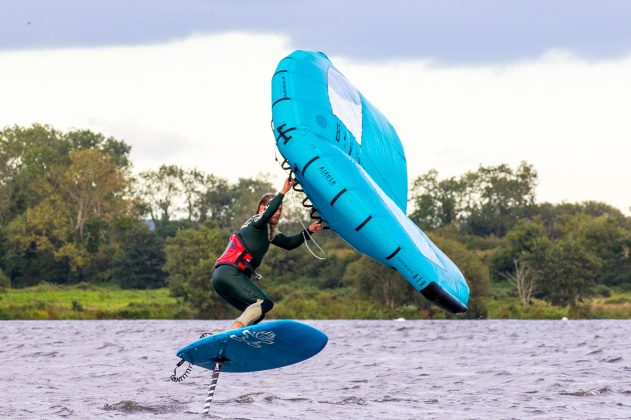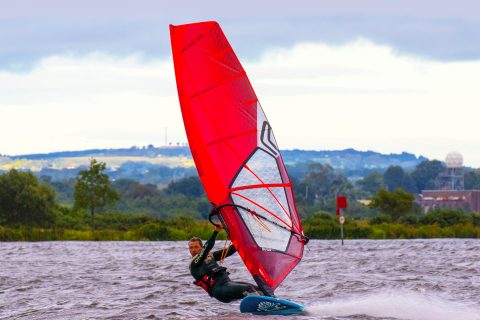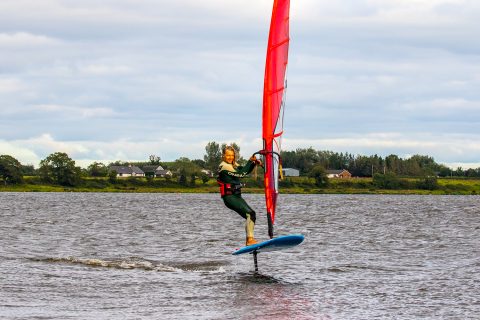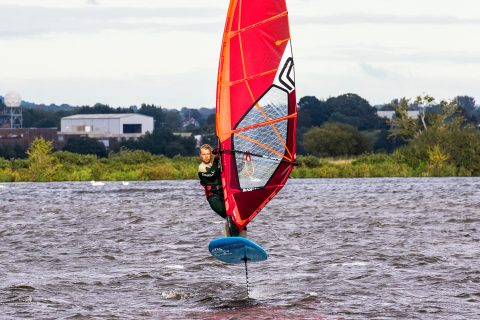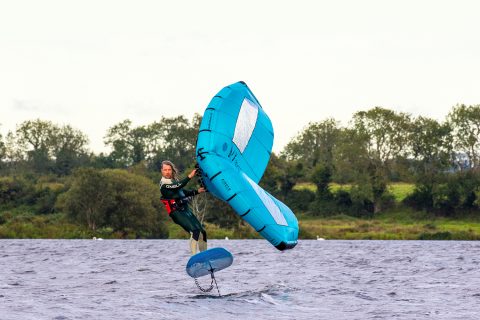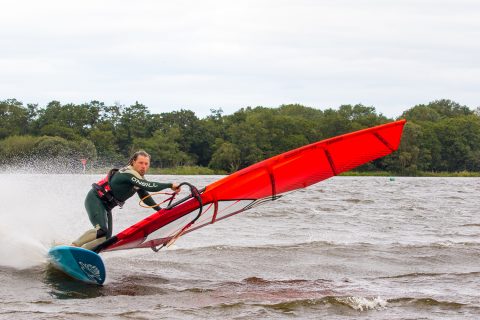From our October edition of Windsurf Magazine, our editor Finn Mullen, takes a light-hearted look at the battle for our ages – fin v foil v wing, as he examines their pros, cons and practicalities.
Words Finn Mullen // Photos Tam Mullen
To read more features like this first, Print and Digital subscriptions are available. Prices include delivery globally for 10 x issues a year!
Technology and trends bring waves of change, but the choice to ride them or not is still personal. And certainly in windsurfing, there has never been more choice available on how you wish to glide on water, standing sideways and powered by the wind. We live in lucky times for our sport, or not, it really depends on who you speak to and their views on the f-word – foiling. It’s a divisive subject, and as if no more fuel to the fire was needed, along comes its partner in crime – winging. Now if at this point you are sitting with your head in your hands, screaming what was voted the UK’s favourite catch phrase, “I don’t believe it,” in homage to Victor Meldrew and to express your exasperation at the mere mention of foil or wing, there is very little I can do from here on in to stop you writing to the Queen demanding my head on a plate, but I’ll give it a try.
FRESH FORMS
Prior to my current job, I spent many years working at sea, where to make for a happy ship there was an unwritten rule that three things were never spoken about – politics, religion and pay. Inevitably, given how closely offshore work is linked to the ups and downs of the world economy, conversations around pay or rather specifically, enforced pay cuts, would arise from time to time, but largely the rule was observed and it was a very secular and apolitical workplace. Windsurfing is too for the most part thankfully, but it is a sport with many different forms and at some point I have to start talking about foiling and winging without issuing a very British hundred forms of sorry. Foiling and winging are here to stay, and in a nod to the zeitgeist of 2020, we are going to have to learn to live with it. But live with what exactly? It’s clear there is a crossover between windsurfing with a fin and windsurfing with a foil, but each has its own strengths and weaknesses, as does wing surfing. In an attempt to find out how they all fit into a modern quiver, I decided to do all three back to back in a similar wind strength and water state to find out.
Now if I were to make this a fair fight, it would have to be one which hit the middle ground in terms of wind speed as the ‘fin’ has the obvious top end advantage and foil the bottom. Force 5 was the median ground I chose and I used flat water with small chop as the water state, as that is where the majority of windsurfing takes place in for this wind speed. Rather than concentrate on the technical ins and outs of each discipline, and get bogged down in jargon, I wanted to look at the practicalities, feelings and advantages or disadvantages that each offered.
- Finn on the Fin!
FIN
So starting with the ‘fin’, I opted for the evergreen combination of a 109 litre freewave board and 5.5 5-batten wave sail, which for my 95 kg felt a fast, easy-planing option in the steady wind on offer. There’s plenty to appreciate when you load up a fin, fully powered in your stance and locked into your harness, chattering along, accelerating and carving at will. The ultimate sailing craft? Well as a windsurfer I’m biased, but even objectively I think it’s hard to surpass the feeling of direct engagement that the sail/board/fin combo brings over anything else single-handedly piloted by a sail, or its versatility. Let’s not forget where we have come from either. In my early days of planing windsurfing the choice for these conditions was to either trade off the speed of a slalom type board for its lack of user-friendliness in anything but a straight line, against the distinctly sluggish nature of a wave board that offered a rewarding but demanding venture to turn and jump. Nowadays, thanks to decades of nuanced refinement in rocker-lines, rails and planforms we have hybrid designs that do it all. So why reinvent the wheel? Does familiarity breed contempt? Modern windsurfers have a heck of a range, so to challenge the fin, there has to be something wholly different on offer, and that is where, in my opinion, a foil does have its place.
- Foil time.
FOIL
Now I do have to declare at this point, not a conflict of interest, rather a divergence of interest when it comes to foiling. My experience of wind foiling was a roundabout journey, in that I came from a SUP surf foiling background before I was able to try wind foiling. And it was purely down to practicalities in that most of my water time is done on a stretch of coast that is rarely flat with very limited opportunities to launch windsurfing gear locally in anything but breaking surf, which much as I can relate to the old joke about sailing being akin to standing under a shower tearing up £10 notes, it’s something I prefer to joke about rather than practice. One point to the ‘fin’ over a foil here because as a pre-requisite to wind foiling you do need somewhere you can launch easily and is free from hazards, natural or otherwise, as there is a large expensive structure a long way beneath your feet. A good friend of mine, an avid and accomplished coastal windsurfer, took his newly acquired foil setup to what he though was a reasonably safe stretch of water to find his feet, an enclosed quiet harbour area with a large reaching area. On his first run he took little notice of a few small buoys and lines ahead, until he hit one that was attached to a large mooring underwater, which promptly sheared his foil from his board (albeit helped by a failure to check his bolts) and he made a generous donation to Davey Jones’ locker. Now cautionary tales aside, if we were to limit our windsurfing to anything where there wasn’t any risk of kit damage, we might as well take up knitting, but there does have to be some extra consideration for foiling.
- Finn free foiling!
SILENCE
So having tuned my ‘radar’ for any anti-foil devices, I swapped my freewave board for my hybrid wind/sup foil board. My wife had been blasting on her 5.0 and being an advocate of ‘free foiling’ where you can use a smaller sail and no footstraps, I grabbed her sail as she took a break and took off, literally. Novice or pro, with sail or without, the overwhelming feeling of any flight on a foil is …silence. Part of the attraction of ‘fin’ windsurfing is blasting along, knuckled down with the wind and spray in your face, and a trail of snot hanging from your nose – all very ‘Rule Britannia’! Foiling is like the ambient Brian Eno version of fin windsurfing, cut up with bursts of the Prodigy at their most anarchic. It’s blissful, peaceful, feels hyper-efficient, the very essence of gliding, mixed up with heart-in-mouth moments where you balance on the edge of over-foiling or breaching, that can result in the mother of all ‘wheelies’ and a cheap castration. Bar having a sail in my arms and board under my feet, it’s a lot different to ‘fin’ windsurfing, but not in a bad way. Foils are a light wind game changer, I’m not going to delve into the physics of it, they just are and arguing otherwise is bit like denying the earth is round at this stage of the game. But the aim of this exercise was to compare everything in the same wind strength, pound for pound, and in that respect, wind foiling gives a fresh set of sensations for the flat water arena, which much as I love fanging around with a fin, it’s not an infinite amount of pleasure. Wind foiling adds that extra something on top to benign conditions; just enough to test you without being insurmountable, and giving a strong sense of accomplishment when it all goes right. There’s plenty to get hooked on, which is ironic given a harness feels superfluous a lot of the time for me. That’s because of how light the sail becomes wind foiling when using a smaller sail as you are generating so much apparent wind with the efficiency of the foil., but there’s still a lot, if not more physical challenges on offer as you balance all the forces; bit of a mind game in there too, so we’ll add mental workout to the list also. Wind foiling is like lots of little micro-puzzles to solve to keep your windsurfing mind, body and soul fresh and not descend into a world-weary, seen-it-all, human. For that alone, it’s worth the rip.
- Wing session!
WING
Now to the new kid on the block, the ‘wing’. It was an easy choice to decide what size of wing to use, as I only have one – a 6.0! There’s a clue there as to something key you soon realize about wings, they might not look like they do, but they have an incredible range. A modern windsurf racing rig does also, but with all its cams, battens and carbon you would hope it does! A wing’s potency in this regard however comes less from its design, but by its nature of use, which means you can vary its power easily and safely at the top end by how you hold it, and the efficiency of the foil takes care of the bottom end. Foils and wings may seem an odd pairing given how one looks highly engineered and the other you blow up, but put them together and the marriage works.
CORDLESS
The changeover from sail to wing was not straightforward and I’ll explain why. Wings are affectionately known as ‘cordless kites’, and kites love to fly, with or without humans attached. So while I could happily talk to passing animals as I changed between my 5.5 and 5.0 sail, a wing left unattended is a wing about to leave on the first gust bound for Kansas. From the moment it’s pumped up, the wing needs to be secured.
You can’t be as carefree either when launching wing and board versus a windsurfer, as being so light the wing is quite mobile and you only have your wrist to make sure the wing doesn’t launch a surprise attack on the tips of your foil and impale itself. As for doing it in surf or a shorebreak, well I’ll let you imagine the comedic scenes until you get the hang of it.
RIGGING
So before we hit the water the wing has a -1, ahh but wait, I told you not to take all you see with a wing at face value. A major plus a wing has is its rigging – the lack of boom, mast and lines is obvious, but you also don’t need the ideal grassy rigging surface that a sail does. Would I rig my shiny, expensive sail on a sandy beach? No, because I’d end up with a not so shiny sail and jammed up mast etc. Ok I would make and have made exceptions, if I was going to score epic wave sailing, but for a regular flat water session I wouldn’t deem the potential gear damage v reward great enough. But a wing is a hardy animal that I can happily rig with a little care on sand or even rocks or slipways that I would never consider rigging a sail on, and it is fairly easy to actually paddle out of a wind shadow that some launch areas have, dragging a wing behind you, so it opens up a lot of areas to sail from that a windsurfer might ignore. And the whole setup is compact to transport, so spots with a long walk are easier too, so let’s just call it an amicable 0-0 for the wing pre water time.
FEELING IT
Under way on the wing there’s an immediate sense of not only foiling’s common trait of silence, but the fact that you are going noticeably slower than a wind foil or windsurfer. Is that a bad thing? The act itself is none the less engaging for it, as without a fixed rig, you really do feel the foil beneath you and the loss of speed is made up for by a feeling of freedom to really explore the manoeuvrability of the setup. Foils, powered by sail or wing, have incredible upwind abilities and that means you can carve up and downwind with little loss of speed or ground. That’s something that is heightened with a wing as your body is able to be more mobile and the wing is less constrained in its points of sail, meaning you can carve back and forth in mini arcs, pretending your Kai Lenny with relative ease once you get the basics down. You can do that too wind foiling, and both sports make the smallest waves or chop incredibly fun to carve on, it’s just winging does it better, and is why you see its application in waves being taken up, not to mention the ability to completely ‘park’ the wing in neutral and just glide freely on a wave. I should mention too that wing foiling uses shorter fuselages than wind foiling generally, which all helps manoeuvrability. But again, I’m concentrating on flat water application and the wing offers another dimension and alternative to explore for those that love to turn, rather than just straight line blasting, which is still a lot of fun on a wing too.
- Finn Laying it down
FRESH BLOOD
Anything new invariably comes with a price tag and sceptics. I’m no early adopter, but I also take the view that my chance to try new things in life decreases with every passing day, week and year, so the best time to experience new things is sooner rather than later.
In sport the 10,000 hour principle used to be accepted as the standard for achieving excellence. So in essence, keep practicing the same thing and you’ll eventually get good at it. That long held theory is now increasingly being eschewed in favour of gaining a breadth of diverse experiences and developing range if you want to excel. The new movements I learn to wind foil or wing all seem to give fresh blood to my windsurfing. Winging or foiling don’t replace or cancel my windsurfing, they help it. Physically winging is not very demanding, so offers an option when tired, but also because your stance is a lot more upright it helps balance out your body from the crouched stance of ‘fin’ windsurfing, so it’s a very good partner sport.
VERDICT
Fin v foil v wing is a vast subject to cover and I’ve only given a slight tongue-in-cheek taste here as much of the strengths and weaknesses come down to what locations you have to sail in and what they offer in terms of launching and wind and water states. A sail on a wind foil board feels and is, very efficient, and has the edge on getting going the earliest; but a wing offers an alternative that feels very ‘surf’ like, something that the very small boards you can use for winging engender a feeling of too. As for a traditional ‘fin’ windsurfer setup, well the connection between rider, rig and board feels to me much more direct in comparison, a bit like being on a motocross bike that you can turn, burn and jump at will, and that’s a nuance that will always have an attraction. But wind foiling and winging definitely have an advantage in gusty, light to moderate conditions, where the foils allow you to glide through lulls that a fin would languish in.
A wise man once said the less time you have, the more toys you need. Meaning if your windows to get on the water are slim, you increase the chances of having a good session if you have the kit to get you out there regardless. And one thing is for sure, if you have a foil or a wing, you definitely get more water time and a lot of reward from mediocre conditions; sounds like a good deal to me! But how do you pay for it you ask? Well as I told you at the start, there are some things at sea you just shouldn’t talk about!


